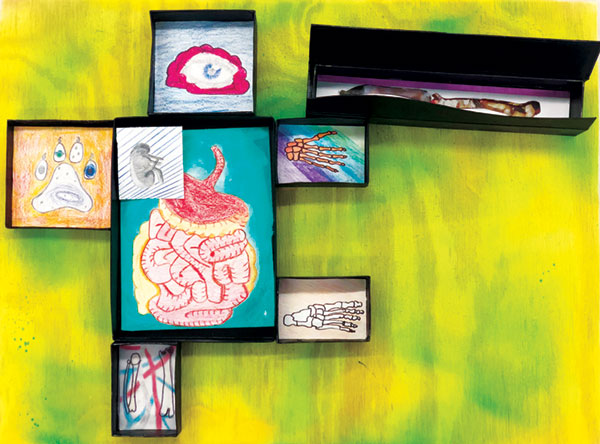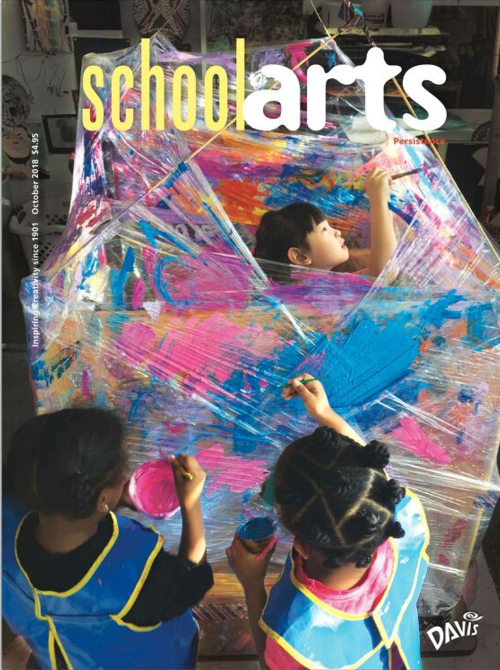 |
| Ethan Wacker, grade eight. |
I also wanted students to learn how to plan projects using large-scale drawings, which helped them in experimenting with colors, materials, and ideas. This project seemed to take on a life of its own as students worked. They had to come up with solutions for challenges such as how to hang their artwork for display. This project kept my students engaged and challenged.
Student Introduction
Class with Mrs. Phelps is not your ordinary art class. We often enter the classroom and have a new layer of our project waiting at our desks. This keeps the class interesting throughout the year, and our projects this semester have been no exception.
Boxed Humans is a mixed-media project that required studying and drawing different parts of the human body and later making a sculpture. We learned to draw, paint, sculpt, and print the body parts we chose including hands, legs, faces, and whatever else we wanted to add to our sculptures. Studying human anatomy was a vital part of this project. The process of drawing involves mistakes and art that students are not always proud of, but Mrs. Phelps’s encouragement makes students want to persist and keep trucking along with their projects and overcome obstacles.
Media
The requirements were simple: create a boxed figure that loosely resembles the human body and create a picture of the body for each one of those boxes. As for the media, that’s a whole other story. We were required to use different types of media and drawing methods for each box, including realism, color scheme, and lines and texture. Some students expanded the project by sculpting with clay and printmaking. One student, Jack McDougall, used things we learned in past projects and incorporated them in his themes and media, such as steampunk and blind contour drawing. We challenged ourselves so we were satisfied with our outcome.
Art comes with mistakes, and all artists should know that. Alex Garcia, another student in the art program, says this: ”Mistakes are meant to be built off of,” and these words are very true. All artists should know that it is okay to mess up, and all artists have to start out somewhere.
Planning with Large-Scale Drawings
To start the project, we took recycled jewelry boxes and positioned them in a way that related to the shape of the human body. We traced our boxes on a huge piece of drawing paper, then filled them with different ideas for body parts and how we could make our art unique. These large-scale drawings showed samples of color, texture, and bulleted notes. These rough drafts became artwork on their own and ended up being completely different from the final projects. This gave them personality and uniqueness.
Adding Square Forms
Pushing boundaries is what an art class is for, and adding ideas to expand our knowledge is a great way to develop our minds. That’s why Mrs. Phelps had us add ideas that kept the form of a square, and then include those ideas in our drawings. These themes of things in “squares” or “fours” could include the four elements, the four times of day, the four dimensions, and the four choral parts of singing. This posed a challenge for some of us and made us really think about our art, rather than tossing it off without effort. This became one of the many requirements of the project that we adapted to.
While working on the project, many students decided to change their drawings and ideas midway. This created a challenge as they came up with new ways to create their art. This is why Mrs. Phelps emphasizes change and the fact that it’s okay to change your ideas so you love what you have created.
Project Results: Teacher Perspective
The project results were assembled pieces that reflected students’ personal styles and learning goals. This project surpassed my expectations. What I thought would be a two-week project meeting every day turned into a month-long project with a few short breaks for other small projects. I followed students’ lead as they wanted to expand their box project ideas and experiment with materials, adding layers by developing their drawing skills. Boxed Humans acted as a final project for the semester, since it had so many elements incorporated into the learning.
.jpg) |
| Caidance Kopac, grade eight. |
Teacher’s Comments:
This lesson is one that I will definitely be using again. It kept growing and students really took charge during the creative process. I shared with the class a copy of SchoolArts and told them that teachers often publish their lessons. This inspired them to say that they wanted to write their own article. I challenged them to start and told them I would help. Harrison went home and got started. During class time, he involved other students by asking them questions and asking them for feedback and help with editing. I took a final look at the article and added my introduction and closing before submitting it. This article was really about students taking the lead.
It was beautiful to watch them grow as leaders and want to share their lesson. I say “their” lesson because they surpassed my own visions for the lesson. Projects where students take on challenges and grow are what make me want to continue teaching.
Process
- Study the human body.
- Arrange recycled jewelry boxes.
- Draw to scale on large white paper.
- Create boxes with mixed media.
- Add “square” activity to project.
- Refine the final product.
- Assemble it on board background.
- Write an artist statement.
Harrison Dodge is a seventh-grade student at Tucson Country Day School in Tucson, Arizona.
Kala Phelps is an art teacher at Tucson Country Day School in Tucson, Arizona. KalaFPhelps@gmail.com
NATIONAL STANDARD
Creating: Conceiving and developing new ideas and artistic work.
View this article in the digital edition.



.jpg)